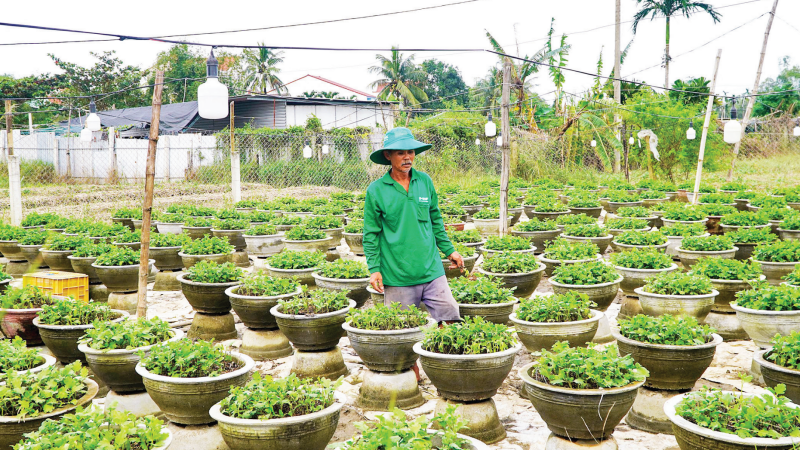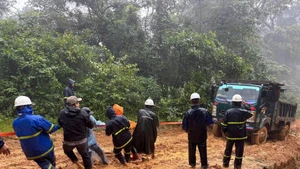The Ha Dong flower village in Dien Ban Bac Ward, Da Nang City specialises in growing potted chrysanthemums for the Tet market. Located in the lower reaches of the Vu Gia–Thu Bon river system, the area was severely impacted during the late-October floods, which wiped out the crops of hundreds of flower-growing households as chrysanthemums suffered root rot and gradually died.
Flower nurseries wiped out by floodwaters
Nguyen Thi Que of Dien Ban Bac Ward, said that in late August 2025 her family planted more than 1,000 pots of chrysanthemums of various sizes. However, the rising and persistent floodwaters submerged the entire crop.
“We were warned of major flooding, so my family moved all the pots and raised everything higher. We do this every year because the water usually only rises about 0.5m. But this year it rose nearly 2m, so we couldn’t move anything further. After more than three months of work and hundreds of millions of VND invested, now nothing is left — and even if we plant again, it won’t be in time,” Que said.
As she cleared and cleaned the remaining pots in hopes of reusing them next year, Nguyen Thi Co, head of the Ha Dong chrysanthemum-growing cooperative group, could only sigh as nearly four months of work and all the capital invested in 400 chrysanthemum pots intended for the Tet market were lost to the floods.
“When chrysanthemum plants are submerged, their roots rot and they can’t survive. All 400 pots across my two gardens have died — there’s no way to revive them. We had hoped to earn enough for a comfortable Tet, but now everything is gone,” she said tearfully.
Nguyen Manh Hung, Secretary of the Dien Ban Bac Ward Party Committee, said the recent floods caused severe damage to the ward, including the loss of 12,850 flower pots and ornamental plants. The local authorities have instructed relevant departments and units to promptly assess household-level losses to plan targeted support. They are also increasing communication efforts, encouraging residents to join hands in overcoming the aftermath and helping affected households stabilise their lives, restore production, and ensure social welfare in the area.
In Hoi An Dong Ward — a key flower-growing area supplying Tet flowers to Hoi An ancient town and neighbouring localities — damage was also extensive, with around 6 hectares of flower crops destroyed, causing losses of more than 10 billion VND (379,400 USD).
In recent days, Nguyen Duc Khanh of Son Pho 2 neighbourhood, Hoi An Dong Ward, has been working constantly in his field, trimming rotted chrysanthemum roots and loosening soil in an attempt to save what remains.
“This season I planted 600 pots of chrysanthemums. When we heard the floods were coming, my son and I worked in the rain and managed to carry more than 200 pots to higher ground. But the water rose too high this year and submerged everything. We invested millions of VND into the crop, so now we’re trying to salvage whatever we can,” Khanh said.
According to Secretary of the Hoi An Dong Ward Party Committee Nguyen Hung, the floods submerged about 80% of the ward’s area. Total losses amounted to around 51 billion VND (1.9 million USD), including nearly 13 billion VND (493,300 USD) in agricultural, forestry and fisheries production. The ward recently received 4 billion VND (151,800 USD) in emergency support from the city. With additional donations from organisations and benefactors, the ward will allocate funds to directly affected households and repair infrastructure damaged by the floods. Specialised units have also been assigned to compile detailed data on Tet flower growers to allocate appropriate support within the ward’s capacity.
Focusing on recovery efforts
According to the Da Nang City People’s Committee, initial estimated losses from the heavy rains and flooding exceed 1.3 trillion VND (49.3 million USD), including 42,850 damaged flower pots and ornamental plants.
In the aftermath, the city instructed departments and localities to prioritise restoring production, business operations and residents’ livelihoods. This includes providing seeds, livestock, and agricultural supplies to revive agro-forestry-fishery production; supporting affected enterprises and household businesses; and stabilising markets to prevent shortages and price manipulation.
Deputy Director of the Da Nang Department of Agriculture and Environment Truong Xuan Ty said the agricultural sector has sent technical staff to assist localities in stabilising production. Sub-departments under the Department are proactively carrying out their duties and coordinating with local authorities to implement recovery measures. They are also guiding communes and wards to apply support policies under Government Decree No. 9/2025/ND-CP dated January 10, 2025 on agricultural production assistance for areas affected by natural disasters and plant pests.
“The agricultural sector is actively guiding localities to focus on restoration efforts and care for the remaining flower crops. For households whose crops were completely destroyed, we are advising them to replant short-duration flower varieties or switch to vegetables to ensure they can sell produce during the upcoming Tet. Relevant units will advise the city leadership and propose timely support measures to the Government so residents can stabilise their lives as soon as possible,” Ty said.
















